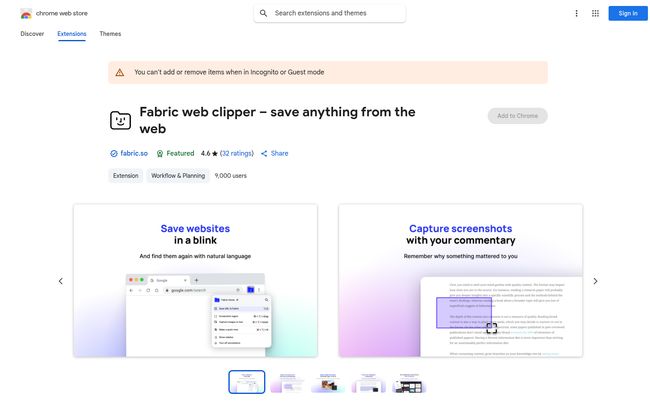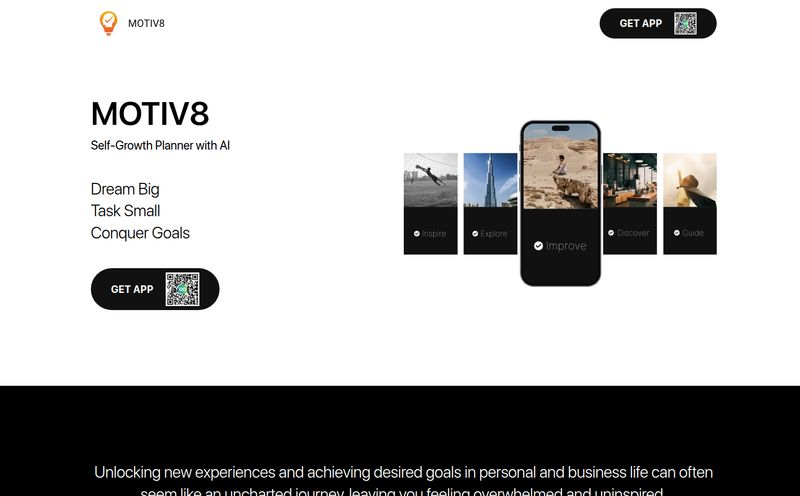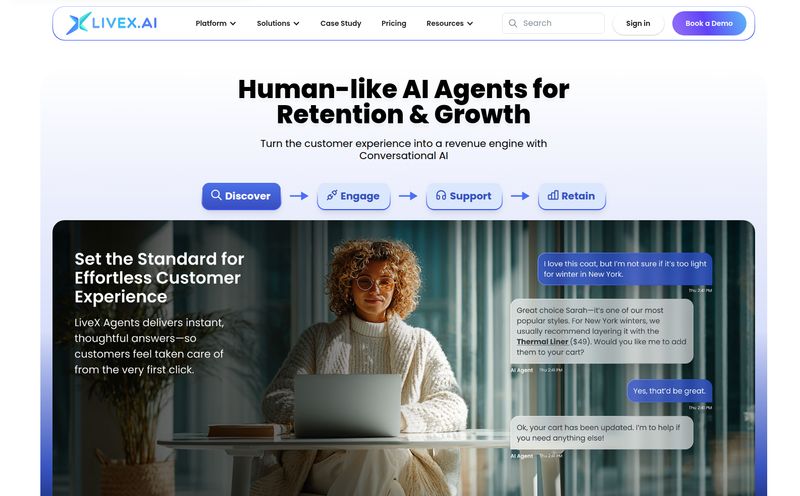If someone mapped out my digital life, it would look less like an organized library and more like a teenager's bedroom after a three-day weekend. There are half-read articles stashed in one bookmarking app, screenshots of brilliant ideas on my desktop, random notes in a Google Doc from 2019, and a whole graveyard of links I swore I'd “read later.”
For years, I've been on a quest for the perfect system—the one tool to rule them all. I’ve tried everything. Complicated Notion setups that took a week to build, simple bookmarking tools that became black holes, and elaborate folder systems that I abandoned after two days. They all failed for one simple reason: they required me to be the organized one.
Then I stumbled across Fabric. The promise was tempting: a self-organizing workspace. An AI search engine for my own stuff. It sounded a little too good to be true, but as a professional digital hoarder (and SEO, which is just organized hoarding), I had to give it a shot.
What Exactly is Fabric, Anyway?
So what is this thing? At its core, Fabric is a new kind of internet drive. Think of it as a central hub or a smart file explorer for everything you collect online. It's not just for files, though. It’s for web pages, notes, images, PDFs, tweets—basically any digital breadcrumb you want to save. You can access it through their website, a desktop app for Mac and Windows, and most importantly, a slick Chrome extension that does most of the heavy lifting.
The whole idea is to stop scattering your digital life across a dozen different apps and just dump it all into one place. A single source of truth. And then—this is the cool part—let an AI figure it all out for you.

Visit Fabric
Drowning in Digital Clutter? You're Not Alone.
The modern internet experience is a firehose of information. As a content creator, I'm constantly researching. I'll find a fascinating statistic for an article, a killer case study, a brilliant tweet thread, and a beautiful website design for inspiration... all in the span of about ten minutes. My instinct is to save it all.
The "I'll Save This for Later" Graveyard
The problem is the retrieval. Where did I save that link about Google's latest algorithm update? Was it in Pocket? Did I email it to myself? Or is it one of the 87 untitled bookmarks in my 'Read Later' folder? This constant, low-grade anxiety of losing good ideas is exhausting. It's a productivity killer and, frankly, it just feels messy.
How Fabric Uses AI to Tame the Chaos
This is where Fabric really tries to stand out. It’s not just another bucket to throw your links into. It's an intelligent bucket. When you save something, Fabric’s AI gets to work, automatically analyzing and tagging the content. It's not just looking at the title; it's understanding what the thing is about. This leads to its killer feature...
The Magic of Natural Language Search
Instead of trying to remember a specific keyword or filename, you can search Fabric like you're talking to a person. It's less like a search bar and more like a personal archivist who just gets you. For example, I recently saved a bunch of articles about sustainable packaging for a client project. A week later, instead of searching for "sustainability" or "packaging", I just typed into Fabric: "that article about mushroom-based packaging". And boom, there it was.
"I’ve always felt that the biggest flaw in digital organization tools is that they rely on our future selves being as diligent as our present selves. Fabric's AI kind of short-circuits that by doing the organizing for you."
This natural language search is a genuine game-changer. It shifts the burden from you having to meticulously tag everything to you just having to remember the gist of what you saved. It’s how our brains actually work.
Automatic Organization: A Blessing and a Curse?
The AI also creates its own connections and labels. It's pretty wild to see it group an article you saved, a screenshot you took, and a note you wrote into a little cluster because it recognized they were all related to the same topic. For someone like me, who hates creating folders, this is fantastic. But I could see how it might feel a bit... unsettling for people who love their manual, perfectly curated systems. You have to be willing to let go of the reins a little and trust the machine.
The Best Parts: My Favorite Fabric Features
After using it for a few weeks, a few things really jumped out at me. The centralized hub concept is a clear winner. Having one place for inspiration, research, and project files simplifies things immensely. The cross-platform accessibility is also huge; I can save a link on my work desktop and immediately pull it up on my personal laptop or web browser at home. Everything just syncs.
The collaboration tools are also surprisingly solid. You can share items or entire spaces with team members, leave comments, and annotate things together. This is great for small teams working on content projects or agencies sharing research with clients. It pulls everything out of endless email chains and into one collaborative space.
What's the Catch? Some Things to Consider
No tool is perfect, right? While I'm pretty bullish on Fabric, there are a few things to keep in mind. First, there's a bit of a learning curve. Not in using the tool itself—it's quite simple—but in trusting it. You have to un-learn years of frantic folder creation and let the AI do its thing. That mental shift takes a minute.
Second, its biggest strength is also a potential weakness. Your organization is heavily reliant on the AI. If the AI misinterprets something, finding it might be tricky, though the powerful search usually overcomes this. And, like most cloud-based tools these days, you are pretty dependent on having an internet connection for it to work its magic.
So, How Much Does Fabric Cost?
This is the part where you usually brace for impact. But here's the surprising bit: as of right now, Fabric appears to be completely free. I've scoured their site and the Chrome Web Store page, and there's no pricing information listed. The extension is listed as in "Beta", which often means the developers are focused on building the user base and refining the product before introducing paid tiers. For early adopters, this is an incredible opportunity to get in on the ground floor of a really promising platform without spending a dime.
My Final Verdict: Is Fabric Worth Adding to Your Workflow?
So, is Fabric the holy grail I’ve been searching for? It’s the closest I’ve come. It’s not trying to be an all-in-one project manager like Notion or ClickUp. It’s doing one thing—capturing, organizing, and finding your digital stuff—and it’s doing it incredibly well.
If you're a researcher, a student, a writer, a designer, or just someone who feels like their digital life is a mess, I honestly think you should give it a try. The AI-powered search alone is worth the price of admission (which, again, is free!). It’s a tool that feels like it was designed for the way our brains actually work, not for how a computer thinks we should work. And for that, it's earned a permanent spot in my dock.
Frequently Asked Questions about Fabric
- 1. What is Fabric and who is it for?
- Fabric is an AI-powered workspace and search engine designed to help you organize all your digital content—links, files, notes, images, etc.—in one place. It's perfect for students, researchers, content creators, and anyone who saves a lot of stuff from the web and struggles to find it later.
- 2. How does the AI search in Fabric work?
- It uses natural language processing. This means you can search using conversational phrases like "that video about making sourdough bread" instead of specific keywords. The AI understands the context and content of what you've saved to find what you're looking for.
- 3. Is the Fabric app really free?
- Yes, at the time of this review, Fabric is in a public beta and is free to use. There are no pricing tiers or subscription fees currently listed on their website or app store pages.
- 4. Can I collaborate with my team using Fabric?
- Absolutely. Fabric has built-in collaboration features that allow you to share specific items or entire collections of content with others. Team members can view, comment on, and annotate the shared materials.
- 5. How is Fabric different from tools like Pocket or Notion?
- Pocket is primarily a read-it-later app for articles. Notion is a comprehensive productivity suite for building databases and documents. Fabric sits in a unique middle ground. It's more versatile than Pocket, accepting all file types, but more focused on AI-driven search and retrieval than the heavy-duty project management of Notion. It's a 'second brain' focused on finding things, not just storing them.
- 6. What platforms is Fabric available on?
- Fabric is accessible via a web app, a desktop application for both MacOS and Windows, and a very handy browser extension for Google Chrome.



